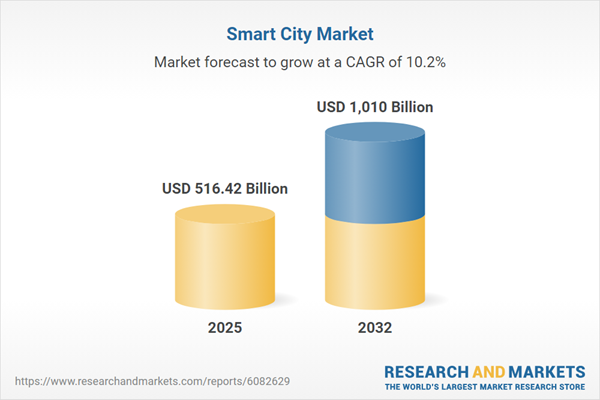Speak directly to the analyst to clarify any post sales queries you may have.
The smart city market is driving a paradigm shift in urban development, with cities worldwide deploying interconnected technologies and infrastructure to respond to evolving population needs, enhance efficiency, and foster long-term resilience. Senior leaders must navigate rapid transformation and rising expectations for integrated solutions designed to optimize municipal operations and societal well-being.
Market Snapshot: Smart City Market Size and Growth
The smart city market expanded from USD 468.69 billion in 2024 to USD 516.42 billion in 2025, projecting continued growth at a 10.15% CAGR and reaching USD 1.01 trillion by 2032. This robust expansion reflects the adoption of digital platforms, connected infrastructure, and innovative municipal solutions, supported by strong government and private sector initiatives. Industry stakeholders prioritize scalable technologies to drive sustainable, data-driven urban development, addressing escalating demand for resource optimization and transformation across both mature and emerging city environments.
Scope & Segmentation
This report offers targeted smart city segmentation to support executive investment and strategic alignment across all major domains and operational models:
- Component: Focus areas include Hardware, Services, and Software—essential to enable innovation and ensure ecosystem capabilities meet evolving municipal requirements.
- Hardware: Key products are Connectivity Modules, Controllers, and Sensors, providing automation, real-time data collection, and interoperability across urban infrastructure.
- Services: Comprising Managed Services and Professional Services, these support solution lifecycle management, upgrades, and critical expert consultation for smooth city operations.
- Software: Involves Analytics Software (predictive and prescriptive), Application Software, and Platform Software, delivering integrated insights, adaptive management, and effective system orchestration.
- Application: Implementation spans Building Automation (including Access Control and HVAC Management), Environmental Monitoring (air and water quality), Smart Healthcare (with Remote Patient Monitoring and Telemedicine), and Smart Lighting (both adaptive and street lighting). These address operational efficiency, public safety, and sustainability in key use cases.
- Deployment Model: Includes Cloud (Hybrid, Private, and Public) and On-premises setups, granting cities flexibility in solution adoption, scalability, and governance.
- Region: Coverage extends to Americas, Europe, Middle East & Africa, and Asia-Pacific. Regional drivers include unique regulatory demands, investment levels, and patterns of urbanization in markets such as the United States, Germany, Brazil, China, and India.
- Key Companies: Leading vendors include Cisco Systems, International Business Machines Corporation, Siemens Aktiengesellschaft, Schneider Electric SE, Huawei Technologies, Microsoft Corporation, Accenture plc, Hitachi Ltd., Telefonaktiebolaget LM Ericsson, and General Electric Company.
Key Takeaways for Senior Decision-Makers: Smart City Market
- Integrated use of IoT, AI, and next-generation connectivity empowers cities to address urban challenges and better allocate resources.
- Edge computing and standardized platforms are streamlining municipal response and enhancing community interactions.
- Regional strategies diverge considerably: Americas prioritize safety and transport, Europe and the Middle East spotlight privacy and sustainability, while Asia-Pacific leverages coordinated government action for accelerated progress.
- Market leaders collaborate within ecosystems and co-develop platforms to shift projects from isolated pilots toward full-scale, coordinated deployments.
- Modern strategies increasingly embed citizen engagement, modular designs, and agile procurement, supporting cities’ ability to remain responsive and future-ready.
- Private equity and strategic investors favor providers with deep integration and cross-domain expertise.
Tariff Impact: Navigating Regulatory Change
With new United States tariffs on electronics and communication equipment introduced in 2025, global supply chains for smart city technologies are being restructured. Stakeholders adapt through diversified sourcing, extended vendor relationships, and reinforced regional partnerships. Urban procurement teams adjust budgets and schedules, leveraging tariff engineering, inventory control, and local manufacturing strategies to maintain project continuity despite policy shifts.
Methodology & Data Sources
This research consolidates primary data from municipal procurement, supplier documentation, and infrastructure logs with secondary analyses of policy frameworks and industry databases. Qualitative insights are captured via interviews with urban planners, technology executives, and service providers, while expert workshops validate segmentation and operational definitions. Forecasts rely on combined top-down and bottom-up scenario models.
Why This Report Matters
- Empowers technology and urban planning executives to anticipate, interpret, and manage ongoing regulatory and technology-driven changes in the smart city ecosystem.
- Offers actionable segmentation and regional context to guide market entry, strategy creation, and risk-aware investment decisions in diverse urban contexts.
- Supplies validated benchmarks and solution frameworks for enabling collaborative transformation and adaptable, resilient city systems.
Conclusion
Digital transformation and cross-sector partnerships are redefining urban living. Smart city stakeholders who prioritize innovation and resilient design will propel the evolution of fair, adaptive, and sustainable cities globally.
Table of Contents
3. Executive Summary
4. Market Overview
7. Cumulative Impact of Artificial Intelligence 2025
Companies Mentioned
The companies profiled in this Smart City market report include:- Cisco Systems, Inc.
- International Business Machines Corporation
- Siemens Aktiengesellschaft
- Schneider Electric SE
- Huawei Technologies Co., Ltd.
- Microsoft Corporation
- Accenture PLC
- Hitachi, Ltd.
- Telefonaktiebolaget LM Ericsson
- General Electric Company
Table Information
| Report Attribute | Details |
|---|---|
| No. of Pages | 180 |
| Published | November 2025 |
| Forecast Period | 2025 - 2032 |
| Estimated Market Value ( USD | $ 516.42 Billion |
| Forecasted Market Value ( USD | $ 1010 Billion |
| Compound Annual Growth Rate | 10.1% |
| Regions Covered | Global |
| No. of Companies Mentioned | 11 |









